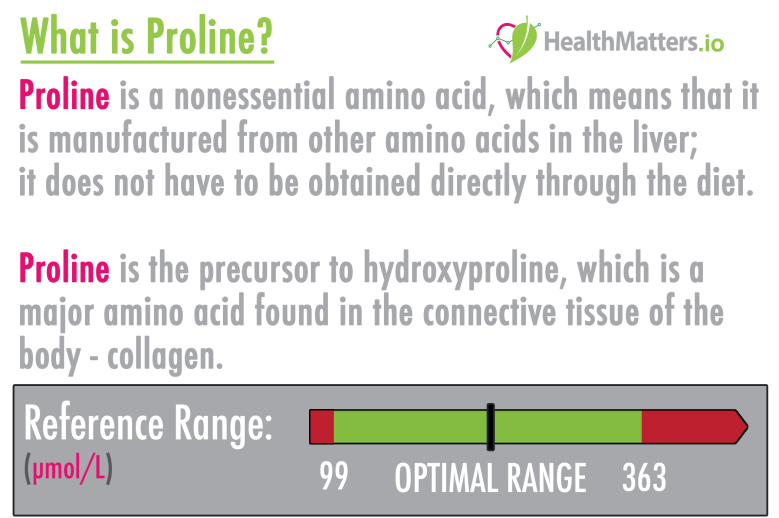Proline is the precursor to hydroxyproline, which is a major amino acid found in the connective tissue of the body – collagen.
– Its effect in human nutrition, other than as a source of nitrogen, is not well established.
– Supplementation with proline has not been found to increase collagen formation.
– Proline is found in virtually every dietary protein except lactalbumin. Although proline is not classified as an essential amino acid, proline levels in plasma are dramatically reduced with a proline-free diet.
– Proline is a major constituent of collagen and can be metabolized to alpha-KG, which is important in ammonia detoxification and the citric acid cycle.-
– Hyperprolinemia is a recognized genetic disorder characterized by renal and central nervous system dysfunction.
– Vitamin C and iron are known cofactors in the conversion to hydroxyproline and may be useful if connective tissue symptoms are present. Acute or chronic deficiency of vitamin C produces a significant increase in the proline/hydroxyproline ration in urine.
– The relationship between proline and hydroxyproline urinary excretion has been used as an index of collagen catabolism.
Lower levels:
– Low plasma levels of proline reflect low tissue supply of this amino acid. As proline is a major component of collagen, low plasma level can mean defective connective tissue synthesis. Alpha-KG could be used to normalize the value.
– Low proline levels can indicate a low protein diet and may prevent optimal connective tissue maintenance.
Higher levels:
– Proline is universally required to protein synthesis and is metabolized to hydroxyproline, an important component in connective tissue. Therefore, high levels may reflect inadequate connective tissue synthesis. Proline can also be oxidized to glutamic acid, requiring niacin as a cofactor precursor.
– Higher levels of proline can demonstrate poor utilization. Add vitamin C to aid collagen synthesis if symptoms present. Niacin (cofactor precursor) helps oxidize proline to glutamate.
– High levels of proline and hydroxyproline may be lowered by supplementing vitamin C and Iron.
– Consistently high levels of proline can potentially be due to a genetic condition called Hyperprolinemia. Levels of blood proline levels can be 3 to 15 times higher than normal levels. [L]
References:
https://ghr.nlm.nih.gov/condition/hyperprolinemia
Disclaimer:
The information on healthmatters.io is NOT intended to replace a one-on-one relationship with a qualified health care professional and is not intended as medical advice.


